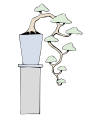
So you want to keep a bonsai tree, you are not alone in this and may be you have even had one before but it died as is common to hear however it probably wasn’t your fault so here is a simple guide to starting out for the first time or having a second go.
Things to do before you buy one or make one or if you are lucky to get given one…
1. Work out where you can keep it first
Decide where you have space to keep a bonsai tree as this will determine what tree species you can have.
Inside
If you only have space on a windowsill or in a conservatory then you need to select a bonsai tree that is tropical or sub tropical so that it can cope with being indoors.
Here are good beginners tropical / indoor trees:-

Olive (Olea)

Figs like Ginsing Fig, Taiwan Fig, Banyan Fig (Ficus)

Jade plant (Crassula or Portulacaria)

Money tree (Pachira)

Pepper tree (Zanthoxylum piperitum)

Citrus – Orange

Cuphea

Crepe Myrtle

Australian Brush Cherry (Eugenia myrtifolia)

Jabotica
Outside
If you have space outside then you need to select a species that is hardy and can cope with the seasonal changes in weather. Here are good beginners hardy outdoor bonsai trees;

Chinese Elm (Ulmus parvifolia)

Korean Hornbeam (Carpinus turczaninowii)
Japanese Box (Buxus microphylla)

Privet (Ligustrum sinense)

Honey suckle (Lonicera nitida)

Japanese Maples (Acer palmatum)

Japanese Larch (Larix kaempferi)

Juniper

Scots Pine (Pinus sylvestris)
2. Select your bonsai tree wisely
Choose what you like about a tree as this will also determine what species you then select. Not all trees have the same features and facets so look for ones that you like first and foremost. All plants, trees, shrubs, succulents and climbers can be kept as bonsai but some are better than others as they have more desirable features that lend themselves to being kept in pots and pruned or shaped.

Flowering (Roses / Forsythia / Styrax / Lilac / Hawthorn / Azalea / Firethorn / Jade plant / Cuphea / Citrus / Jasmine)

Evergreen (Yew / Pine / Cypress / Box / Cotoneaster / Most tropical trees / Lonicera / Podocarpus / Giant Redwood)

Deciduous (Oak / Beech / Hornbeam / Birch / Ash / Elm / Ginkgo / Larch / Dawn Redwood / Hawthorn / Styrax)

Autumn colour (Maples / Ginkgo / Korean Hornbeams / Stewartia / Ivy / Larch / Cryptomeria / Dawn Redwoods / Katsura / Beech)
3. Choose the size of tree you want

Small in size (2.5cm -25cm) (Mame up to shohin)

Medium (25-60cm = Katade mocha up to Chuhin)

Large in size (80-200cm =Omono or Bonju up to Imperial bonsai)
4. Choose a style?
Are you looking to buy a ready made and styled tree or semi trained to develop or do you want to style one yourself and train it. Here are the types of styles you can buy.

Formal upright

Informal upright

Slanting

Wind swept / Literati / Bunjin

Broom

Cascade / multi trunk cascade

Semi cascade
Exposed root / Root over rock / Clinging to a rock

Twin or two trunks, three trunks, 5 trunks, 7 trunks, 9 trunks / Multi trunk

Clump, Raft, Group, Forest
5. What age of bonsai do you want?
You can buy or grow your own plants to make into a bonsai from seed right through to a fully mature bonsai so depending on how long you want to wait will depend on what you start with.
- Seedling (Cheap but will be slow to develop and if grown in pots will take years to develop into a larger bonsai tree- ideal for Mame though)
- Sapling (Cheap but will be slow to develop and limited pruning practice initially as tree needs to grow first but ideal for Mame though)

- Air layering (Cheap and does not always work, and need suitable tree to air layer)

- Cuttings (Cheap but very slow but rewarding, but need suitable trees to take cuttings of first)
- Grafting (Good way to get a more unusual species of tree but perhaps not at the beginners stage)
- Garden centre plant (Good quality stock at reasonable prices can be found and gets you a plant that is used to being in a pot already)

- Nursery stock tree (Good quality stock at reasonable prices can be found and gets you a well developed trunk already with good roots and used to being in a pot)
- Collected material from the wild or your garden (Cheapest way to dig up a plant but can take time to train the roots to fit into a pot initially)

- Starter bonsai (Cheap to buy and a good starting point to then learn and develop them on)

- Mature bonsai (Can be quite expensive to buy but well worth it if you can afford it and want the finished result to admire)
Happy bonsai keeping…and maybe you will start to expand your collection and try out new ideas like others have already begun too. If you need more help visit one of your local bonsai clubs or societies for more advise on what to buy and where.



You must be logged in to post a comment.